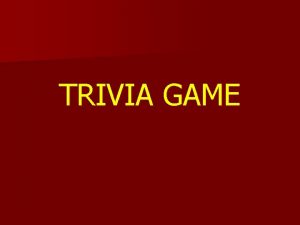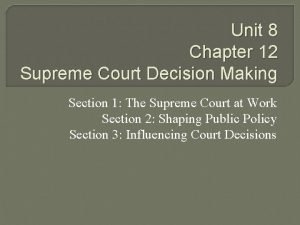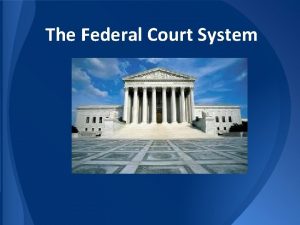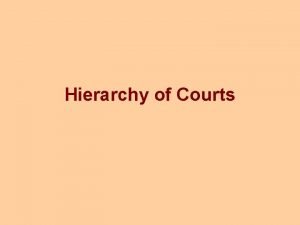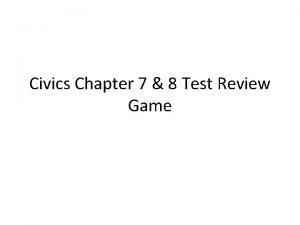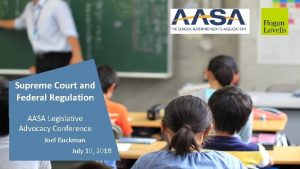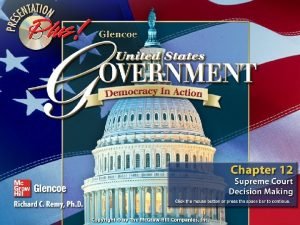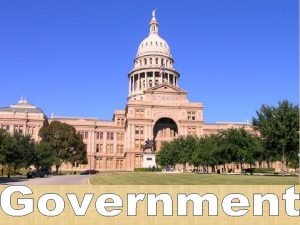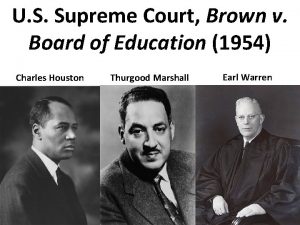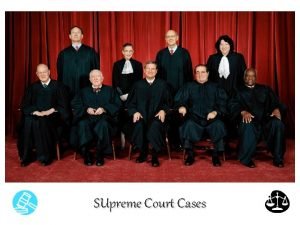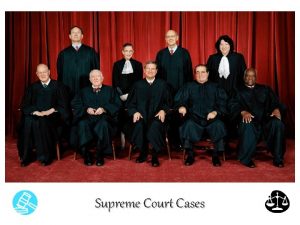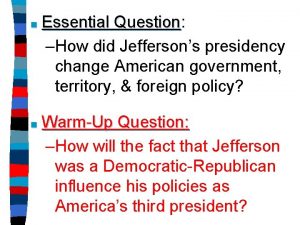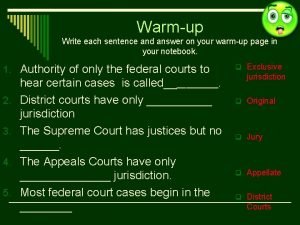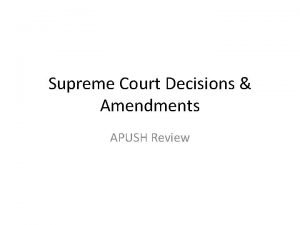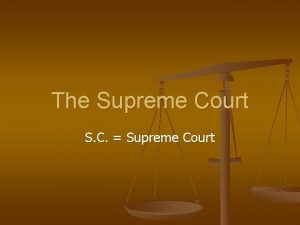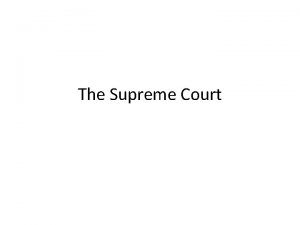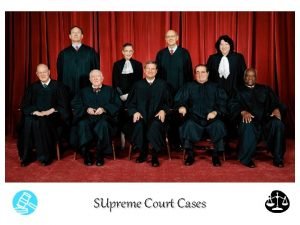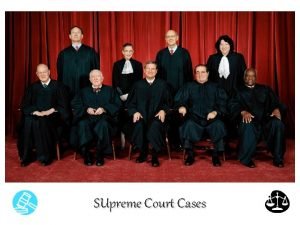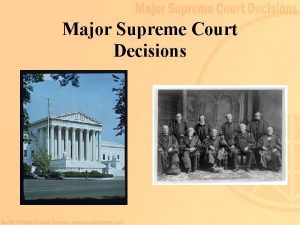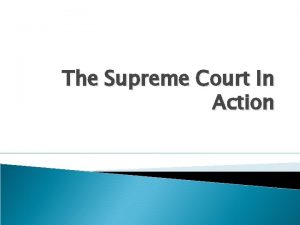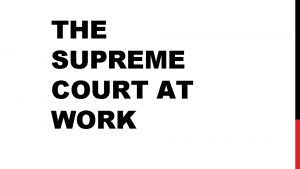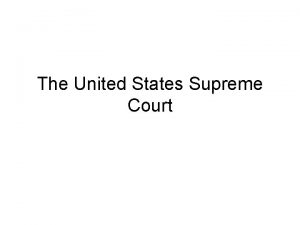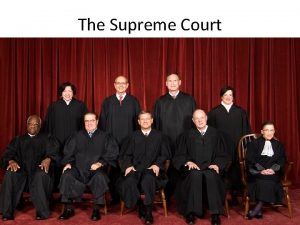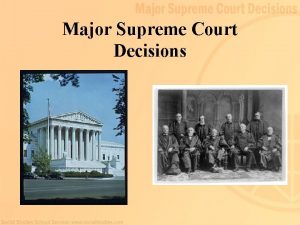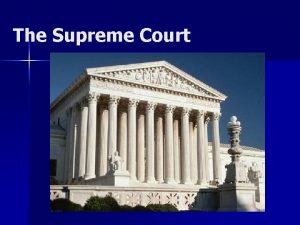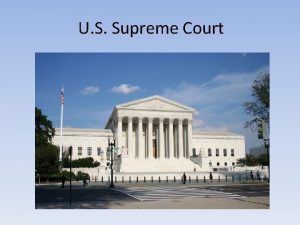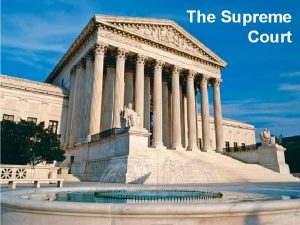Tuesday 415 Agenda Supreme Court Notes Electoral Process



















- Slides: 19

Tuesday 4/15 �Agenda • Supreme Court Notes • Electoral Process Notes/Videos • Campaign Project

Civics and Economics Day 51

Supreme Court Organization • There are 9 Justices 1 Chief – 8 Associate – Congress has the power to change this – • Duties Hear and rule on cases. – Write a written explanation for the decision called an Opinion. – • The President appoints the Supreme Court Justices when one retires or dies.

Supreme Court Powers The other branches must follow the Supreme Courts rulings. Judicial Review Power to review any federal, state, or local law to determine if it is constitutional (Follows the constitution).

Marbury v. Madison • • 1803 court case that established the Supreme Court had the power to decide whether laws were constitutional. Judicial Review established that: Constitution is supreme law of the land – If a law contradicts the constitution, constitution wins. – Judicial Branch should uphold the constituion. –

Who are the Supreme Court Justices?

Back row (left to right): Sonia Sotomayor, Stephen G. Breyer, Samuel A. Alito, and Elena Kagan. Front row (left to right): Clarence Thomas, Antonin Scalia, Chief Justice John G. Roberts, Anthony Kennedy, and Ruth Bader Ginsburg

How do the People on the Supreme Court Lean politically? Liberal Sonia Sotomayor Ruth Bader Ginsburg Elena Kagan Stephen Breyer • Conservatives – Anthony Kennedy (Swing) – Clarence Thomas – (Chief Justice) John Roberts – Antonin Scalia – Samuel Alito

Median Retirement Age 78. 7 Antonin Scalia 3/11/1936 Age: 76 yr 7 mo Ronald Reagan 9/26/1986 Served: 26 yr 1 mo Anthony Kennedy 7/23/1936 Age: 76 yr 3 mo Ronald Reagan 2/18/1988 Served: 24 yr 8 mo Clarence Thomas 6/23/1948 Age: 64 yr 4 mo George H. W. Bush 10/23/1991 Served: 21 yr 0 mo Ruth Bader Ginsburg 3/15/1933 Age: 79 yr 7 mo Bill Clinton 8/19/1993 Served: 19 yr 2 mo Stephen Breyer 8/15/1938 Age: 74 yr 2 mo Bill Clinton 8/3/1994 Served: 18 yr 2 mo John G. Roberts 1/27/1955 Age: 57 yr 9 mo George W. Bush 9/29/2005 Served: 7 yr 1 mo Samuel A. Alito, Jr. 4/1/1950 Age: 62 yr 7 mo George W. Bush 1/31/2006 Served: 6 yr 9 mo Sonia Sotomayor 6/25/1954 Age: 58 yr 4 mo Barack Obama 8/8/2009 Served: 3 yr 2 mo Elena Kagan 4/28/1960 Age: 52 yr 6 mo Barack Obama 8/7/2010 Served: 2 yr 2 mo

Electoral Process

Election Process 1. Primary Campaign/Primary 2. Nominating Convention 3. General Campaign 4. Election

Election Process 1. Primary People in each party campaign against each other for the right to participate in the main election

Election Process 1. Primary 2. Nominating Convention This is where each party announces who will be participating in the general election for presidency. They also take this time to adopt the party’s platform.

http: //www. takepart. com/video/what-arepresidential-nominating-conventions-civicsminute-video

Election Process 1. Primary 2. Nominating Convention 3. General Campaign This is where the selected candidate from each party is trying to woo voters to vote for them. This is a competition usually between the democratic and republican candidate.


Election Process 1. Primary 2. Nominating Convention 3. General Campaign 4. Election The last step in the process is the election. Voters cast their votes for their candidates and the candidate with the most votes wins!

http: //www. takepart. com/video/who-else-ballotyear-civics-minute-video

Special Case: Electoral College The President isn’t technically elected by the people, but instead the electoral college. http: //www. takepart. com/video/electoralcollege-civics-minute-video
 Is there a basketball court above the supreme court
Is there a basketball court above the supreme court What do these headlines say about how the supreme court
What do these headlines say about how the supreme court Vocabulary activity 12 supreme court decision making
Vocabulary activity 12 supreme court decision making Us circuit court map
Us circuit court map The supreme court change
The supreme court change Jurisdiction of high court
Jurisdiction of high court The u.s. supreme court works chiefly as a(n)
The u.s. supreme court works chiefly as a(n) Supreme court does
Supreme court does Supreme court does
Supreme court does Have supreme court
Have supreme court Victorian court hierarchy
Victorian court hierarchy Supreme court
Supreme court Supreme court
Supreme court Insular cases apush
Insular cases apush Cohens vs virginia apush
Cohens vs virginia apush Which precedent was established by the supreme court
Which precedent was established by the supreme court John marshall
John marshall John marshall supreme court
John marshall supreme court How cases reach the supreme court worksheet answers
How cases reach the supreme court worksheet answers Apush supreme court cases
Apush supreme court cases
